C3.2 Neural Signalling SL + HL
1/63
There's no tags or description
Looks like no tags are added yet.
Name | Mastery | Learn | Test | Matching | Spaced |
|---|
No study sessions yet.
64 Terms
CNS (central nervous system)
Consists of brain and spinal chord
PNS (peripheral nervous system)
Nerves in the body
Why is the Nervous System important?
Allows us to make sense of our surroundings and respond to them to coordinate and regulate body functions through electrical impulses.
What is a nerve made of?
A bundle of neurones
What are electrical impulses?
Electrical signals that pass along nerve cells
What is the purpose of the CNS?
Acts as the coordinating center for electrical impulses incoming/exiting
What is the structure of a nerve cell?
- axon: long fibre helps electrical impulse to pass through nerve cell
- Myelin sheath: insulated by Shwann cells- so nerve impulse is transmitted faster
- Dendrites: to make connections to other neurones + communicate easily
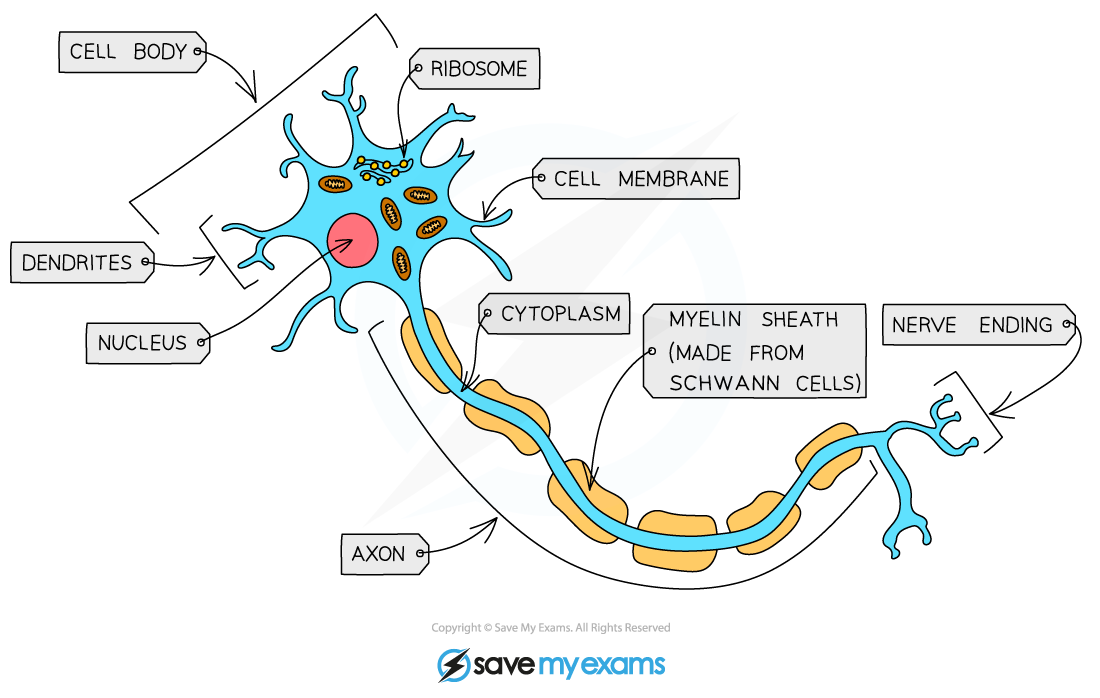
What are the 3 types of neurones:
- Sensory neurone
- Relay neurone
- Motor neurone
What is the function of a sensory neurone?
Carries electrical impulses from receptors to CNS
What is the function of a relay neurone?
Connect sensory and motor neurones to CNS
What is the function of a motor neurone?
Carries electrical impulses from CNS to effectors (muscles or glands)
How does structure of each neurone differ?
Motor neurone:
- Large cell body on one end
- Nucleus is always in cell body
- Highly branched dendrites from cell body (high SA for axon terminals)
Relay neurone:
- Short
- Highly branched
- Many axons and dendrites
Sensory neurone:
- Cell body branches off in the middle
- Long dendron that carries impulse to cell body/ long axon to carry impulse away from cell body
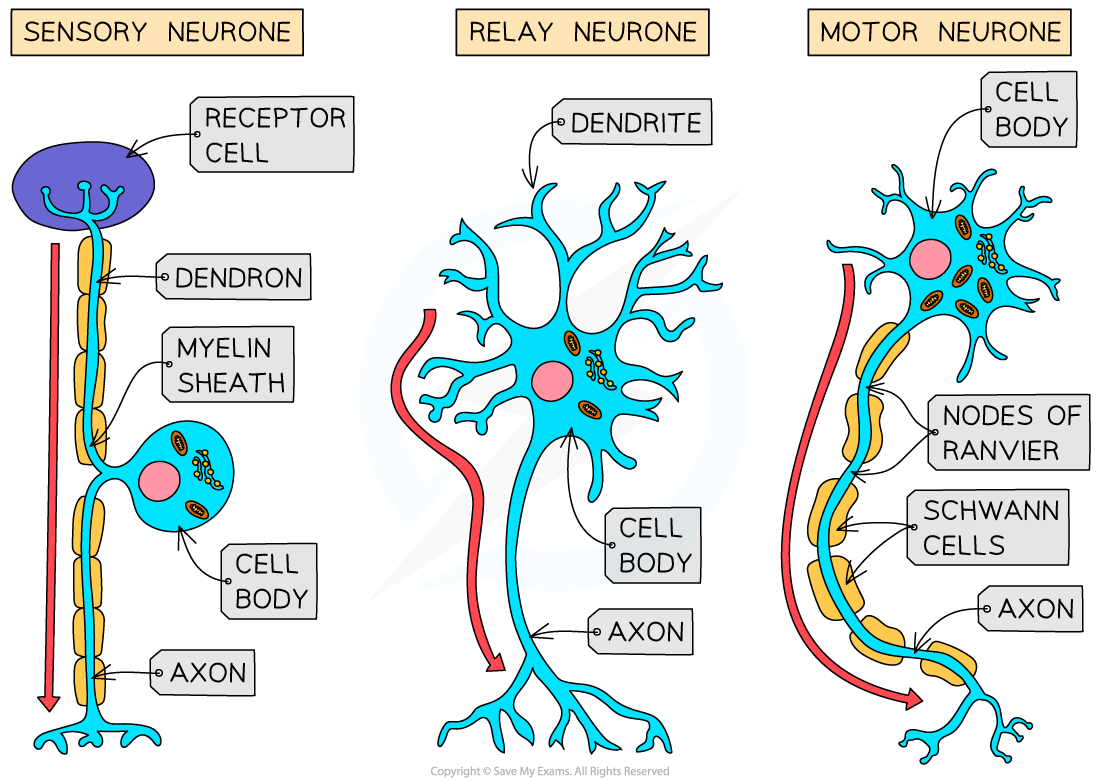
What is an electrical impulse?
A momentary reversal in the electrical potential difference across the neurone cell surface membrane
What is the resting potential?
The electrical charge difference across the plasma membrane of a resting (non-excited) neuron or muscle cell.
What is the resting potential?
-70mV
What is the charge of an axon at rest?
Inside of the axon is negatively charged compared to the outside which is positively charged
What 3 processes help maintain a negative resting potential?
Active transport of sodium and potassium using Na+/K+ pumps
Leak channels
Negatively charged proteins inside the axon
How does active transport help with maintaining a resting potential?
Sodium Potassium pumps use ATP to pump 3Na+ ions out of the axon, and 2K+ ions into the cell
This causes the inside to become more negative
How do leak channels help keep inside negative?
K⁺ leak channels allow K+ ions to move out more easily than Na⁺ can move in
How does the difference in the rates of diffusion of Na+ and K+ help keep the inside of the axon negatively charged?
- Neurone membrane is less permeable to Na+ ions compared to K+ ions
- So K+ ions can diffuse out at a faster rate than Na+ ions can diffuse in
- So there more positive ions on the outside of the neurone than on the inside
What is depolarisation?
The reversal of the electrical potential difference across the membrane
Influx of positive ions into the neurone
When does depolarisation occur?
Depolarisation occurs when the action potential has been generated.
What is an action potential?
An action potential is the potential electrical difference produced across the axon membrane when a neurone is stimulated
When is an action potential generated?
An action potential is generated when a stimulus causes the inside of the axon to become more positively charged than the outside.
How is an action potential generated?
- Sodium ion channels open in axon membrane
- Sodium channels diffuse into the axon down their concentration gradient.
- Once the charge has been reversed from -70 mV to +40 mV, action potential is generated
What are voltage gated ion channels?
Local currents 4 marker
1. Na+ enters (diffuses in)
2. Depolarisation- voltage changes from positive to negative
3. Repolarisation- voltage changes from negative to positive
4. Local currents due to diffusion of Na+ ions along neurone
5. Local currents cause next sodium channel to open
6. Opening of sodium channels triggered when threshold potential reached.
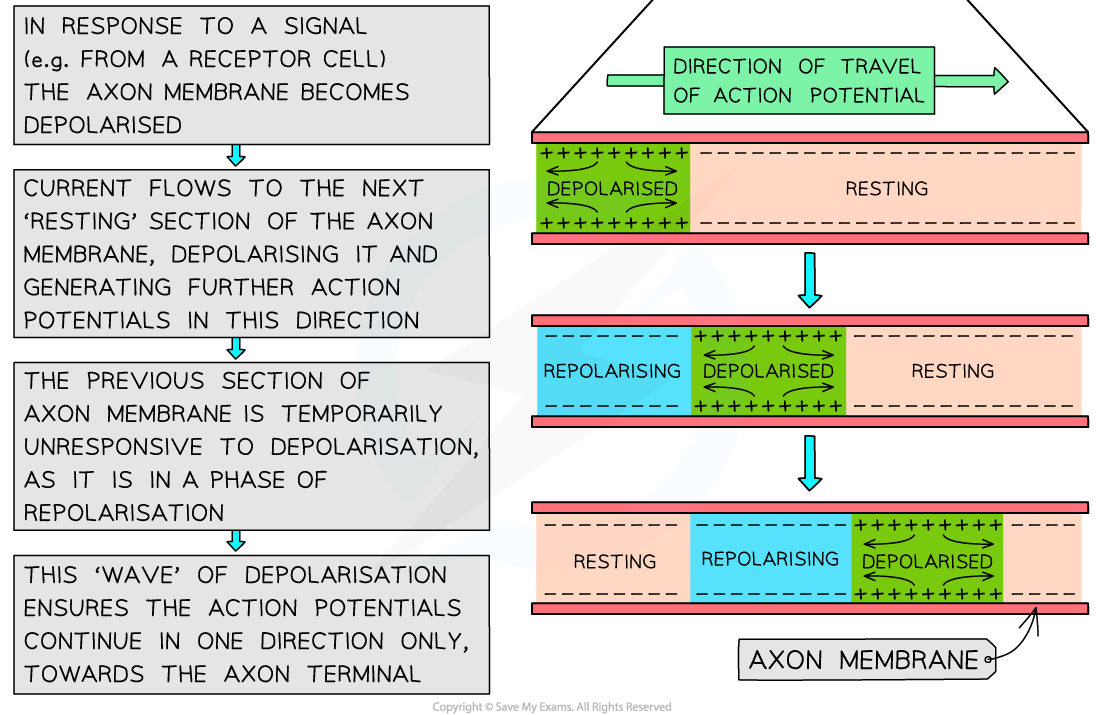
How does depolarisation occur?
- Stimulus causes sodium ion channels to open if threshold is strong enough
- Sodium channels move into the membrane
- This causes the inside of the axon to become less negative
- Inside becomes positive (reaches +30mV)
- Depolarisation causes action potential to be reached
What is repolarisation?
The movement of potassium ions causes the inside of the axon to become negatively charged again
How does repolarisation occur?
- After depolarisation, Na+ ion channels close
- Voltage gated K+ ions open, so K+ ions flow out of the neuron
- This makes the inside of the axon more negative again
- It returns to its resting potential (-70mV)
How does the action potential graph look?
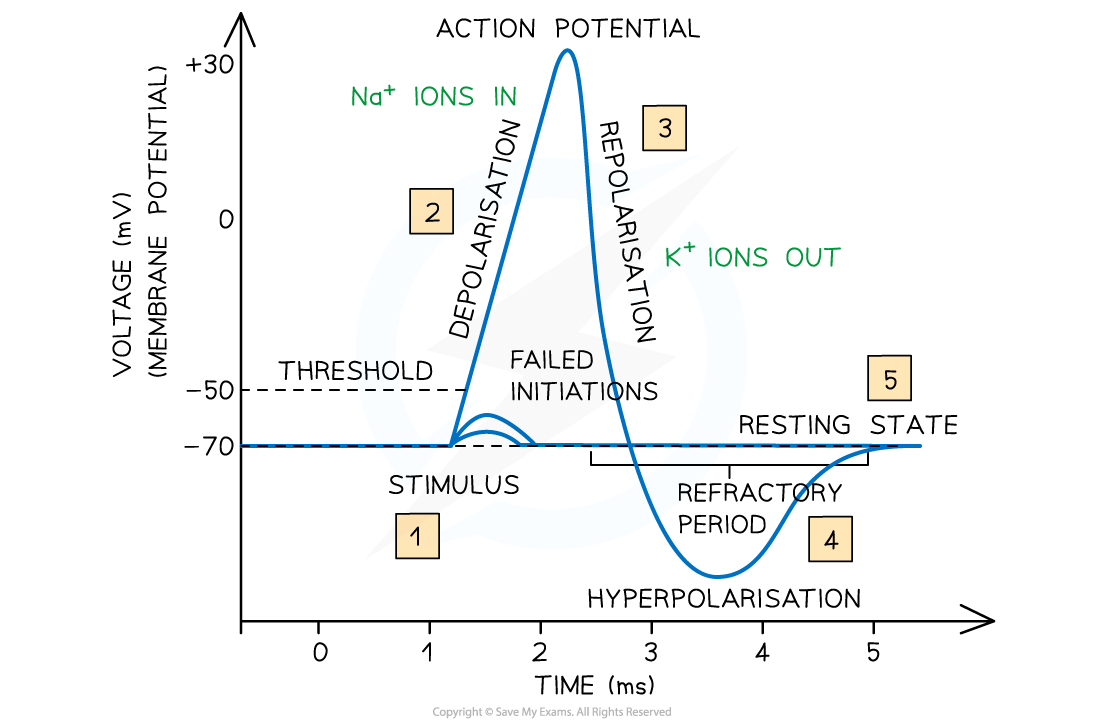
What is needs to happen in order for an action potential to be propogated?
Stimulus must reach the threshold potential
What is hyperpolarisation?
When the membrane potential becomes more negative than the resting potential (drops below -70 mV)
Why does hyperpolarisation occur?
Potassium ion channels remain open for too long
so more K+ ions leave than necessary, making the inside more negative
What is the refractory period?
Short period of time after an action potential when a neuron can’t fire another impulse, or needs a stronger-than-usual stimulus to do so.
Why does the refractory period occur?
Sodium (Na⁺) and potassium (K⁺) channels are returning to their resting states
What is the all or nothing principle?
Too weak stimulus- only a few Na+ ion channels will open so membrane potential will not reach threshold- action potential not generated
An impulse is only transmitted if the initial stimulus is sufficient to increase the membrane potential above a threshold potential
How does the intensity of the stimulus affect the frequency of the stimulus?
As intensity increases, the frequency of the stimulus increases
What are local currents?
Small movement of Na+ along the axon that help spread the nerve impulse from one part of the neuron to the next.
Why do we need local currents?
To allow the action potential (electrical signal) to travel along the axon
How are local currents used to pass an action potential from one area of the neuron to the next?
- Na+ ions rush into the axon making it more positive- depolarisation
- There is a high Na+ ion concentration in the depolarised area (few Na+ ions in the next section)
- Na+ ions diffuse into the axon from the depolarised area to the next depolarised section.
- This raises the membrane potential of the next section
- If membrane potential is high enough, membrane potential is reached
- Na+ ion channels open and a new action potential is generated
- This causes a constant wave of depolarisation
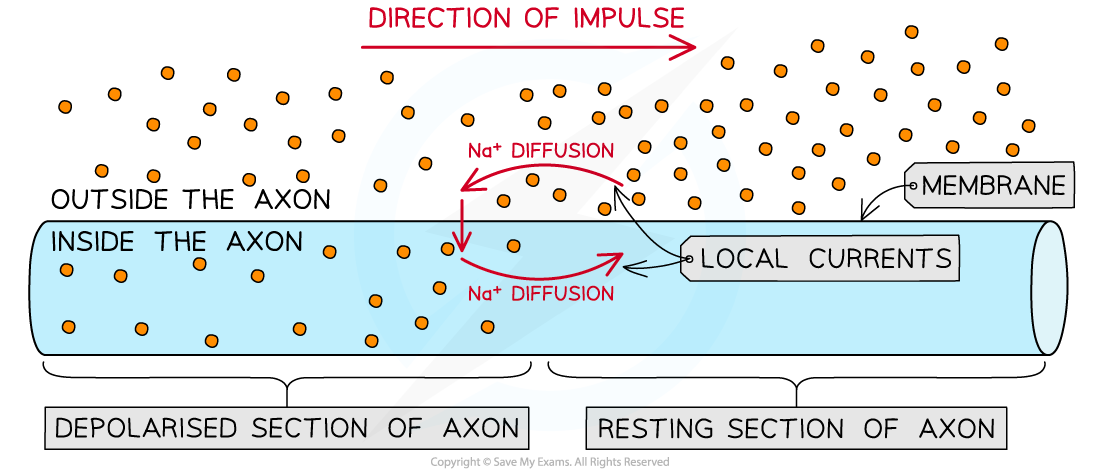
What is saltatory conduction?
Saltatory conduction is how nerve impulses jump from one node to the next along a myelinated axon, making them travel faster
How does the myelin sheath insulate the axon?
- The axon is wrapped in myelin, made by Schwann cells.
- Myelin acts like insulation, stopping Na⁺ and K⁺ ions from diffusing across the membrane.
- So, depolarisation can’t happen in myelinated sections
What are the nodes of Ranvier?
- small uninsulated gaps in the Myelin
Ion channels and pumps are concentrated here.
Depolarisation only happens at the nodes.
Because depolarisation can only happen at the nodes, the action potential jumps from one node to the next.

What are Neonicotinoids?
Substance that blocks synaptic transmission by binding to acetylcholine receptors. This means acetylcholine receptors are blocked, acetylcholine is unable to bind, which stops impulses from being transmitted across synapses
Why is the binding of Neonicotinoids irreversible?
Because acetylcholinesterase cannot be broken down
Why are Neonicotinoids used?
Used as pesticides to kill insects- useful because they're not toxic to humans and other mammals
What is cocaine?
A drug which blocks the reuptake of neurotransmitters into the presynaptic knob
How does cocaine work?
Cocaine works which blocks the reuptake of neurotransmitters into the presynaptic knob
Which neurotransmitter does cocaine prevent the reuptake of?
Cocaine prevents the reuptake of dopamine as it binds to the dopamine transporter protein.
This means that dopamine is not able to move through the membrane back into the presynaptic neurone.
Why do cocaine users feel pleasure?
Because dopamine builds up in the synapses
What long term changes occur in the brain of regular cocaine users?
The brain responds by increases numbers of dopamine receptors to respond to the high levels of dopamine
What do more dopamine receptors cause?
Increased sensitivity and depression
What is the difference between inhibitory and excitatory neurotransmitters?
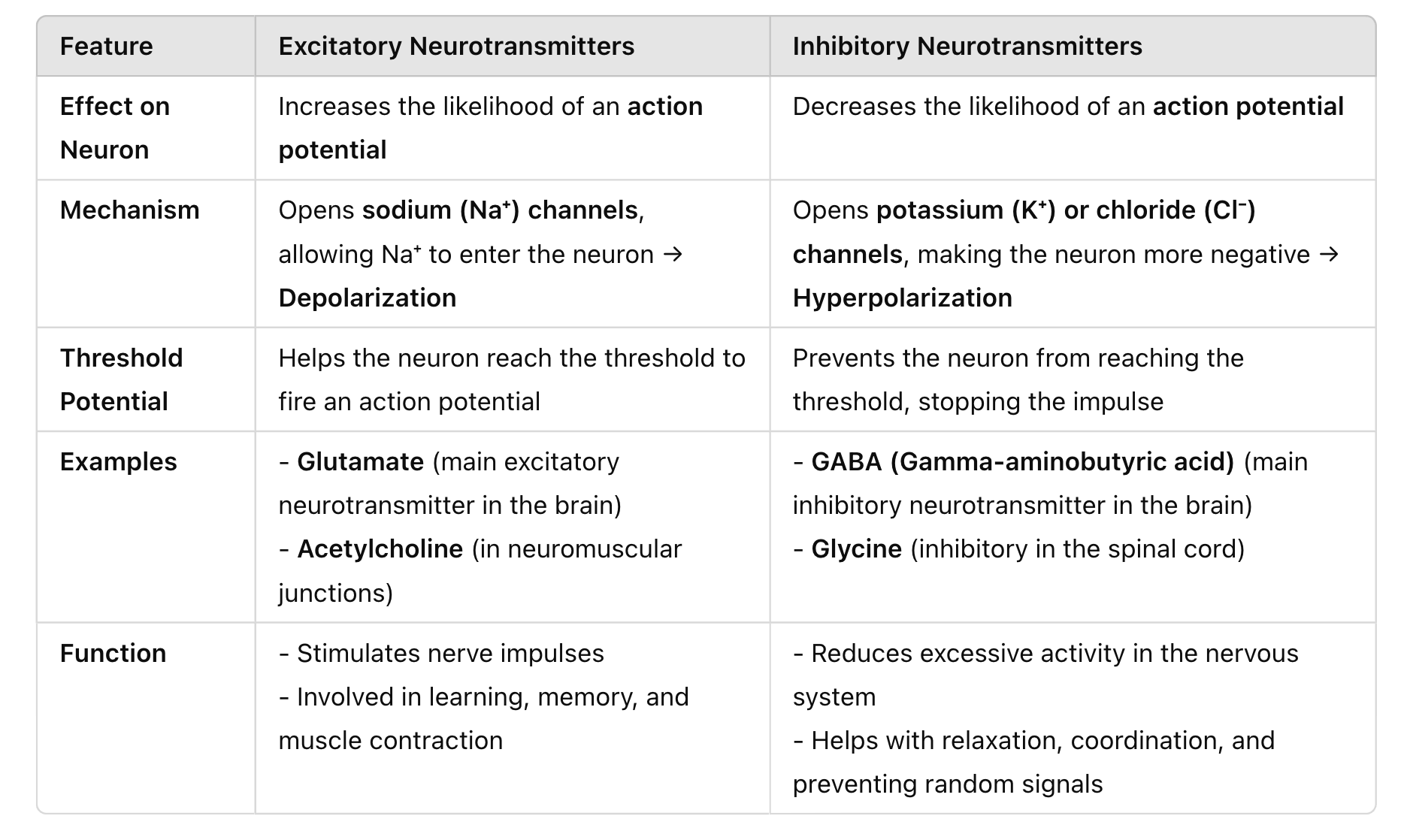
How do inhibitory neurotransmitters work?
Neurotransmitter opens K+ ion channel, K+ diffuses out —> making the neurone hyperpolarised
Hyperpolarised neurone cannot reach threshold potential
No action potential created
What happens if a neurone recieves both inhibitory and exhibitory signals?
Their effects can cancel out, stopping the impulse.
Why are inhibitory synapses important?
- They prevent random impulses from being sent around the body
- They allow for specific pathways to be stimulated
What is temporal summation?
Same neurone carries out multiple impulses within quick succession so effect can be added together to generate an action potential.
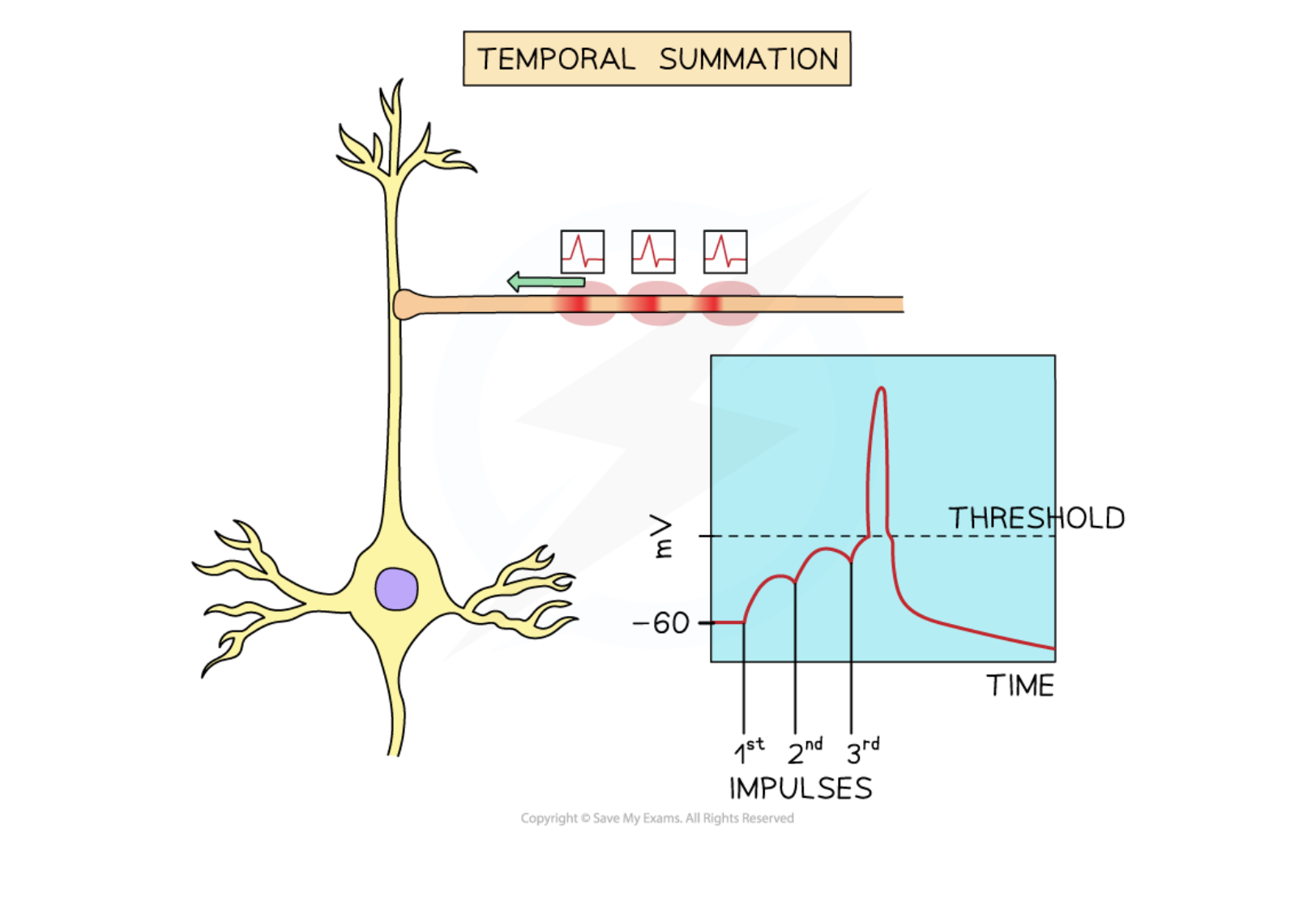
What is spatial summation?
Different neurones simultaneously carry out an
impulse stimulating an action potential.
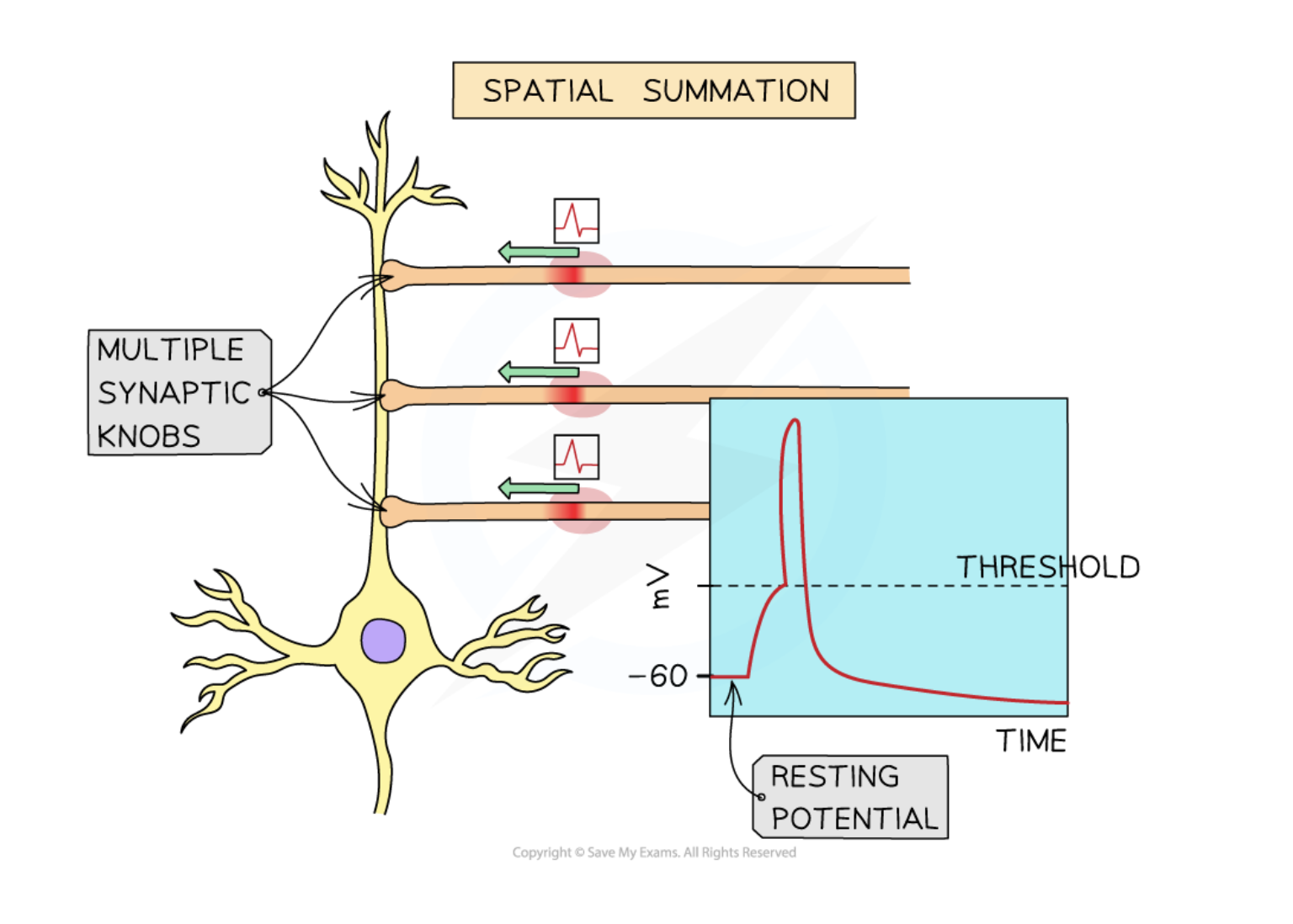
What are pain receptors?
Nocireceptors are sensory receptors with encapsulated free nerve endings that detect harmful stimuli
What are transient receptor potential channels (TRP)?
ion channels found in the membranes of sensory neurons used for detecting temperature, pain, touch, and chemical stimuli.
How do pain receptors work?
- Entry of positively charged ions causes the threshold potential to be reached
- Action potential generated that moves from sensory neurone to CNS
- Nerve impulses passes through neurones to the cerebral cortex in the brain, where pain is perceived and a protective response results
Outline the sequence of events that occur from capsaicin in chili peppers to the triggering of a pain response in neurons? (4 marks)
- Capsaicin binds to noci / pain receptors on free nerve endings in the skin. (1 mark)
- Ion channels open in response to capsaicin. (1 mark)
- Positively charged ions (e.g., Na⁺, Ca²⁺) enter the neuron, depolarizing the membrane and reaching the threshold potential. (1 mark)
- An action potential is generated and transmitted to the brain, where pain is perceived (1 mark)
Predict what might happen if the ion channels in free nerve endings were blocked or non-functional?
- Stimuli (e.g., high temperature, acid, or capsaicin) would not be able to trigger the opening of ion channels. (1 mark)
- No influx of positively charged ions (Na⁺, Ca²⁺) would occur, preventing depolarization of the neuron. (1 mark)
- Threshold potential would not be reached, so no action potential would be generated. (1 mark)
- No nerve impulses would reach the brain,resulting in a lack of pain perception despite the presence of a painful stimulus. (1 mark)
- This could lead to conditions like congenital insensitivity to pain, where individuals do not feel pain even when injured.